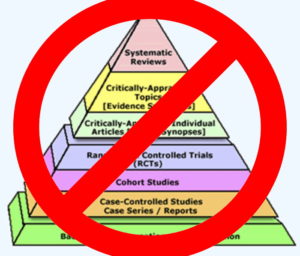The Future of Evidence-Based Fitness
For the last 3 years, Evidence-Based Fitness has languished in blog posts for a number of reasons, but the most important one is this: I really don’t feel like I have anything unique to say that I haven’t already said. I started Evidence-Based Fitness as a countermovement to fishy scams selling things with no justification for their claims. But as time as marched on, the market has gotten savvier, and scammers are just marketing as if they do have scientific evidence for their claims. The use of the term “evidence” has soared as a substitute for “legitimate”, when actually, nothing has actually changed. Just like certain branding on foods have health auras, branding a product or service as “evidence-based” has a “validity aura”. Read More...
What if you ACTUALLY learned to do this?
When I started Evidence-based Fitness in 2007, my goal was to draw attention to how research informs, and misinforms health decisions; that what a research paper says it shows, isn’t always what it shows. I thought that by doing this, writers, coaches, and doctors would realize that learning the skill of complex literature analysis position them to responsibly advise others about their health. After professionally editing complex academic literature for nearly a decade I knew I could lead by example. By modelling good practice, it would lead to good practice. But that hasn’t happened. Health practitioners still don’t have the analysis skills they want.. Health writers still rely on watered-down press releases. This has resulted in a noise-filled infosphere where all opinions seem equal. People actually think putting a stick of butter in their coffee is good for them. Read More...
The most important thing
I get asked a lot about critical appraisal (i.e. how to read a research paper). I have never had a good answer because it’s not a single skill, but the convergence of many skills coming together to help you understand what someone else has done in their experiment and how that applies to both the actual question they answered and the context in which that answer fits in the larger context of the field in which they are doing the work. Read More...
Non-nutritive sweeteners: The pain continues
It’s been 2 weeks since the systematic review and meta-analysis on non-nutritive sweeteners was published. Let’s look at what happened on how it was reported. If you are interested in my interpretation of the July 2017 systematic review and meta-analysis published in the Canadian Medical Journal, which is what these media examples were reporting on, the link is here. Read More...
Non-nutritive sweeteners: This is going to hurt.
This is going to hurt. Read More...
Ping ponging with IFAST (Part 2): Thoughts on mentoring: Belief
 Teaching swing dancing as a skill is a great analogy of mentoring where failure equals loss.
Teaching swing dancing as a skill is a great analogy of mentoring where failure equals loss.
The art of social partner dancing is already rare. People do not want to feel like they look stupid. If you make them feel, regardless of how they actually look, like they look stupid, they will not come back. If you make them feel like something is overly complicated, they will not come back. Building a swing dance scene is a little bit like being a door-to-door salesperson; you have one opportunity to make your mark, or lose your audience forever. Read More...
Ping-ponging with IFAST on mentorship (Part 1)
I was going to write a post about belief and mentoring, but the post took on a life of its own and this tangent became so important that I thought breaking the idea up into two parts would be better. Read More...
“Why is a plastic surgeon concerned about respiration?”
This was the most frequently asked question of this weekend at the Myokinematics course hosted by my friend Bill Hartman at IFAST. I am not going to reveal the second and third most frequently asked questions because some things that are asked at Myokin stay at Myokin. Read More...
The long-anticipated fall of the systematic review
 You may have noticed that for a blog that is called “Evidence-Based Fitness”, that there is not one single mention or reference to the “Hierarchy of Evidence” pyramid. This is entirely intentional. I can’t count the number of blog drafts that I’ve tried to write and then scrapped on how much I hated the old “hierarchy of evidence”. But this week, the Evidence-Based Medicine “pyramid” has finally been reworked. It’s not as graphically pretty. It does, however, better reflect the reality of the “this is not actually how it works” pyramid of old. The new infographic was revealed and can be found here (it’s even open access!) So what does this new infographic mean?
You may have noticed that for a blog that is called “Evidence-Based Fitness”, that there is not one single mention or reference to the “Hierarchy of Evidence” pyramid. This is entirely intentional. I can’t count the number of blog drafts that I’ve tried to write and then scrapped on how much I hated the old “hierarchy of evidence”. But this week, the Evidence-Based Medicine “pyramid” has finally been reworked. It’s not as graphically pretty. It does, however, better reflect the reality of the “this is not actually how it works” pyramid of old. The new infographic was revealed and can be found here (it’s even open access!) So what does this new infographic mean?
In a nutshell, it means there are no more simple answers and no more simple classifications. It means you can’t skip steps. It hopefully means an end to the blind application of a clearly dysfunctional classification system to interpret and compare studies to one another. Read More...